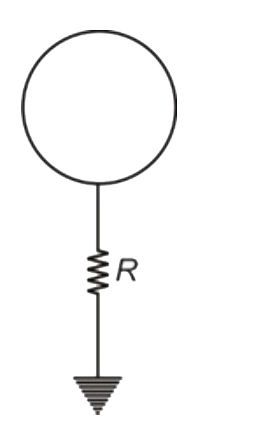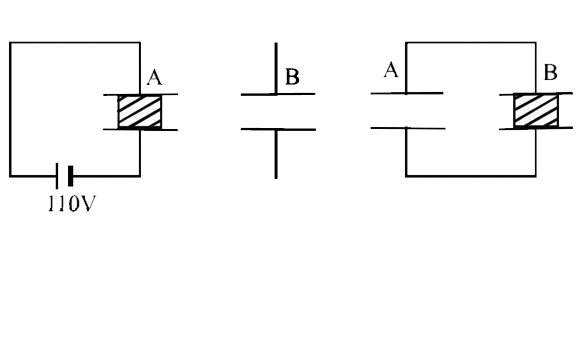A cloud is at a potential of 8×106 volt relative to the ground. A charge of 80 coulomd is transferred in lightening stroke betwee the cloud and the gorund. Assuming the potential of the cloud of remain constant, the energy dissipated is
6.4×108 joule
6.4×105 joule
105 joule
107 joule
The correct Answer is:A
To solve the problem, we need to calculate the energy dissipated during a lightning stroke when a charge is transferred from the cloud to the ground. The energy dissipated can be calculated using the formula:
Energy(E)=Charge(Q)×Potential(V)
1. Identify the given values:
- Potential of the cloud, V=8×106 volts
- Charge transferred, Q=80 coulombs
2. Use the formula for energy:
E=Q×V
3. Substitute the values into the formula:
E=80C×8×106V
4. Calculate the energy:
E=80×8×106
E=640×106J
5. Convert to standard scientific notation:
E=6.4×108J
6. Final Answer:
The energy dissipated during the lightning stroke is:
E=6.4×108J
- Potential of the cloud, V=8×106 volts
- Charge transferred, Q=80 coulombs
E=Q×V
E=80C×8×106V
E=80×8×106
E=640×106J
E=6.4×108J
The energy dissipated during the lightning stroke is:
E=6.4×108J
Topper's Solved these Questions
- ELECTROSTATICSBOOK - AAKASH SERIESCHAPTER - ELECTROSTATICSEXERCISE - PRACTICE SHEET (EXERCISE -IV ELECTRIC POTENTIAL & POTENTIAL ENERGY) (LEVEL - II (ADVANCED) STRAIGHT OBJECTIVE TYPE QUESTION)
28 Videos
- ELECTROSTATICSBOOK - AAKASH SERIESCHAPTER - ELECTROSTATICSEXERCISE - PRACTICE SHEET (EXERCISE -IV ELECTRIC POTENTIAL & POTENTIAL ENERGY) (LEVEL - II (ADVANCED) MORE THAN ONE CORRECT ANSWER TYPE QUESTION)
1 Videos
- ELECTROSTATICSBOOK - AAKASH SERIESCHAPTER - ELECTROSTATICSEXERCISE - PRACTICE SHEET (EXERCISE -III ELECTRO FLUX & GAUSS.S LAW) (LEVEL - I (MAIN) INTEGER TYPE QUESTIONS
2 Videos
- ELECTROMAGNETICSBOOK - AAKASH SERIESCHAPTER - ELECTROMAGNETICSEXERCISE - ADDITIONAL EXERCISE
13 Videos
- ELEMENTS OF VECTORSBOOK - AAKASH SERIESCHAPTER - ELEMENTS OF VECTORSEXERCISE - QUESTIONS FOR DESCRIPTIVE ANSWERS
10 Videos
Similar Questions
The voltage of clouds is 4×106 volt with respect to ground. In a a lightening strike lasting 100 sec, a charge of 4 coulomb is delivered to the ground. The power of lightening strike is
View SolutionA conducting bolloon of the radius a is charged to potential V0 and held at a large height above the earth ensures that charge distribution on the surface of the balloon remains unaffected by the presence of the earth. It is connected to the earth through a resistance R and a value in the balloon is opened . The gas inside the balloon escapes from value and the size of the balloon decreases. The rate of decrease in radius of the balloon is controlled in such a manner that potential of the balloon remains constant. Assume the electric permittivity of the surrounding air equals to that of free space (ε0) and charge cannot leak to the surrounding air.

The rate at which radius r of the balloon changes with time is best represented by the equation
View SolutionOne end of a rod of length 20cm is inserted in a furnace at 800K The sides of the rod are covered with an insulating material and the other end emits radiation like a black body. The temperature of this end is 750K in the steady state The temperature of the surrounding air is 300K Assuming radiation to be the only important mode of energy transfer between the surrounding and the open end of the rod, find the thermal conductivity of the rod Stefan's constant σ=6.0×10−8Wm−2K−4 .
View SolutionOne end of a rod length 20cm is inserted in a furnace at 800K. The sides of the rod are covered with an insulating material and the other end emits radiation like a blackbody. The temperature of this end is 750K in the steady state. The temperature of the surrounding air is 300K. Assuming radiation to be the only important mode of energy transfer between the surrounding and the open end of the rod, find the thermal conductivity of the rod. Stefan constant σ=6.0×10−1Wm−2K−4 .
View SolutionOne end of a rod length 20cm is inserted in a furnace at 800K. The sides of the rod are covered with an insulating material and the other end emits radiation like a blackbody. The temperature of this end is 750K in the steady state. The temperature of the surrounding air is 300K. Assuming radiation to be the only important mode of energy transfer between the surrounding and the open end of the rod, find the thermal conductivity of the rod. Stefan constant σ=6.0×10−1Wm−2K−4 .
View SolutionThe voltage of clouds is 4×106V with respect to ground. In a lighting strike lasting 100ms, a charge of 4C is delivered to the ground. The power of ligthing strike is
View SolutionA proton is moving along the negative direction of X-axis in a magnetic field directed along the positive direction of Y-axis. The proton will be deflected along the negative direction of
View SolutionTwo parallel plate capacitors A and B have the same separation d=8.85×10−4m between the plates. The plate area of A and B are 0.04m2 and 0.02m2 respectively. A slab of dielectric constant (relative permittivity) K=9 has dimensions such that it can exactly fill the space between the plates of capacitor B.

(i) The dielectric slab is placed inside. A as shown in figure (a). A is then charged to a potential difference of 110V. Calculate the capacitance of A and the energy stored in it.
The battery is disconnected and then the dielectric slab is moved from A. Find the work done by the external agency in removing the slab from A.
(iii) The same dielectric slab is now placed inside B, filling it completely, The two capacitors A and B are then connected as shown in figure(c). Calculate the energy stored in the system.
View SolutionA point charge q1 is held stationary at the origin. A second charge q2 is placed at a point a, and the electric potential energy of the pair of charges is −6.4×10−8J. When the second charge is moved to point b, the electric force on the charge does 4.2×10−8J of work. What is the electric potential energy of the pair of charges when the second charge is at point b?
View SolutionA silver ball of radius 4.8 cm is suspended by a thread in a vacuum chamber, Ultraviolet light of wavelength 200nm is incident on the ball for some time during which a total light energy of 1.0×10−7 J falls on the surface. Assuming that on the average one photon out of every ten thousand is able to eject a photoelectron, find the electric potential at the surface of the ball assuming zero potential at infinity. What is the potential at the centre of the ball?
View Solution
